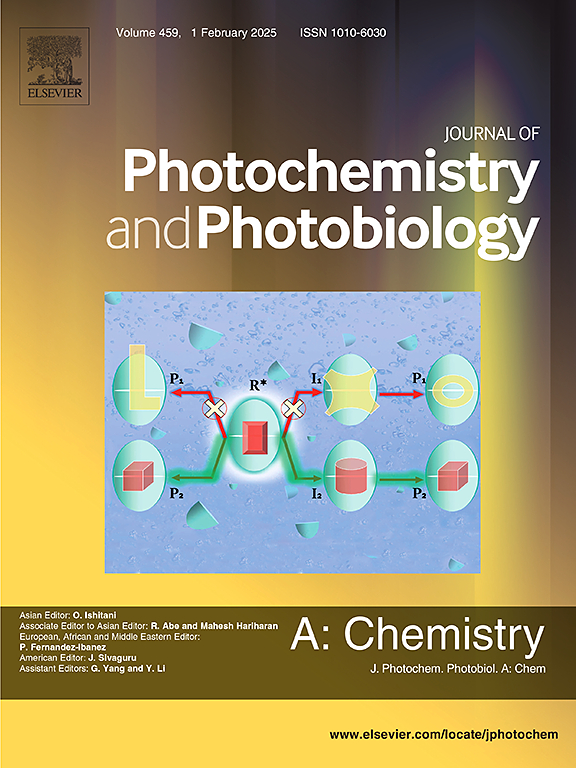Improved piezo-photocatalytic performance of ultra-thin BaTiO3 nanosheets with exposed {001} facets
IF 4.1
3区 化学
Q2 CHEMISTRY, PHYSICAL
Journal of Photochemistry and Photobiology A-chemistry
Pub Date : 2025-04-21
DOI:10.1016/j.jphotochem.2025.116445
引用次数: 0
Abstract
The photocatalytic efficiency of the catalyst is significantly influenced by the separation distance between photogenerated electrons and holes. In this study, ultrathin tetragonal BaTiO3 nanosheets with a thickness of approximately 20 nm and exposed {001} facets were successfully synthesized via hydrothermal method. Subsequent photocatalytic degradation experiments revealed that the ultrathin nanosheet structure possesses enhanced deformability, significantly increased specific surface area, and improved light transmittance. Driven by out-of-plane piezoelectric fields perpendicular to the {001} facets, charge carriers migrate shorter distances toward the nanosheet surfaces to participate in catalytic reactions, effectively suppressing carrier recombination. Surface oxygen vacancies further facilitate charge separation. Under simultaneous ultrasonic and light irradiation, the BaTiO3 nanosheets achieved 93.9 % methylene blue degradation within 60 min, outperforming both BaTiO3 nanowires and nanoparticles. This microstructural optimization enhances the material’s piezo-photocatalytic performance, offering a novel strategy for catalytic enhancement. While the exposed {001} facets may reduce carrier migration distances, further investigation is required to elucidate the anisotropic charge transport mechanisms.

{001}面外露的超薄BaTiO3纳米片提高了压电光催化性能
催化剂的光催化效率受光生电子与空穴的分离距离的显著影响。本研究成功地通过水热法制备了厚度约为20 nm的四边形超薄BaTiO3纳米片。随后的光催化降解实验表明,超薄纳米片结构具有增强的变形能力,显着增加了比表面积,并改善了透光率。在垂直于{001}面的面外压电场的驱动下,载流子向纳米片表面迁移较短的距离以参与催化反应,有效地抑制载流子的重组。表面氧空位进一步促进电荷分离。在超声和光同时照射下,BaTiO3纳米片在60 min内对亚甲基蓝的降解率达到93.9%,优于BaTiO3纳米线和纳米颗粒。这种微结构优化提高了材料的压电光催化性能,为催化增强提供了一种新的策略。虽然暴露的{001}面可能减少载流子迁移距离,但需要进一步研究阐明各向异性电荷输运机制。
本文章由计算机程序翻译,如有差异,请以英文原文为准。
求助全文
约1分钟内获得全文
求助全文
来源期刊
CiteScore
7.90
自引率
7.00%
发文量
580
审稿时长
48 days
期刊介绍:
JPPA publishes the results of fundamental studies on all aspects of chemical phenomena induced by interactions between light and molecules/matter of all kinds.
All systems capable of being described at the molecular or integrated multimolecular level are appropriate for the journal. This includes all molecular chemical species as well as biomolecular, supramolecular, polymer and other macromolecular systems, as well as solid state photochemistry. In addition, the journal publishes studies of semiconductor and other photoactive organic and inorganic materials, photocatalysis (organic, inorganic, supramolecular and superconductor).
The scope includes condensed and gas phase photochemistry, as well as synchrotron radiation chemistry. A broad range of processes and techniques in photochemistry are covered such as light induced energy, electron and proton transfer; nonlinear photochemical behavior; mechanistic investigation of photochemical reactions and identification of the products of photochemical reactions; quantum yield determinations and measurements of rate constants for primary and secondary photochemical processes; steady-state and time-resolved emission, ultrafast spectroscopic methods, single molecule spectroscopy, time resolved X-ray diffraction, luminescence microscopy, and scattering spectroscopy applied to photochemistry. Papers in emerging and applied areas such as luminescent sensors, electroluminescence, solar energy conversion, atmospheric photochemistry, environmental remediation, and related photocatalytic chemistry are also welcome.

 求助内容:
求助内容: 应助结果提醒方式:
应助结果提醒方式:


